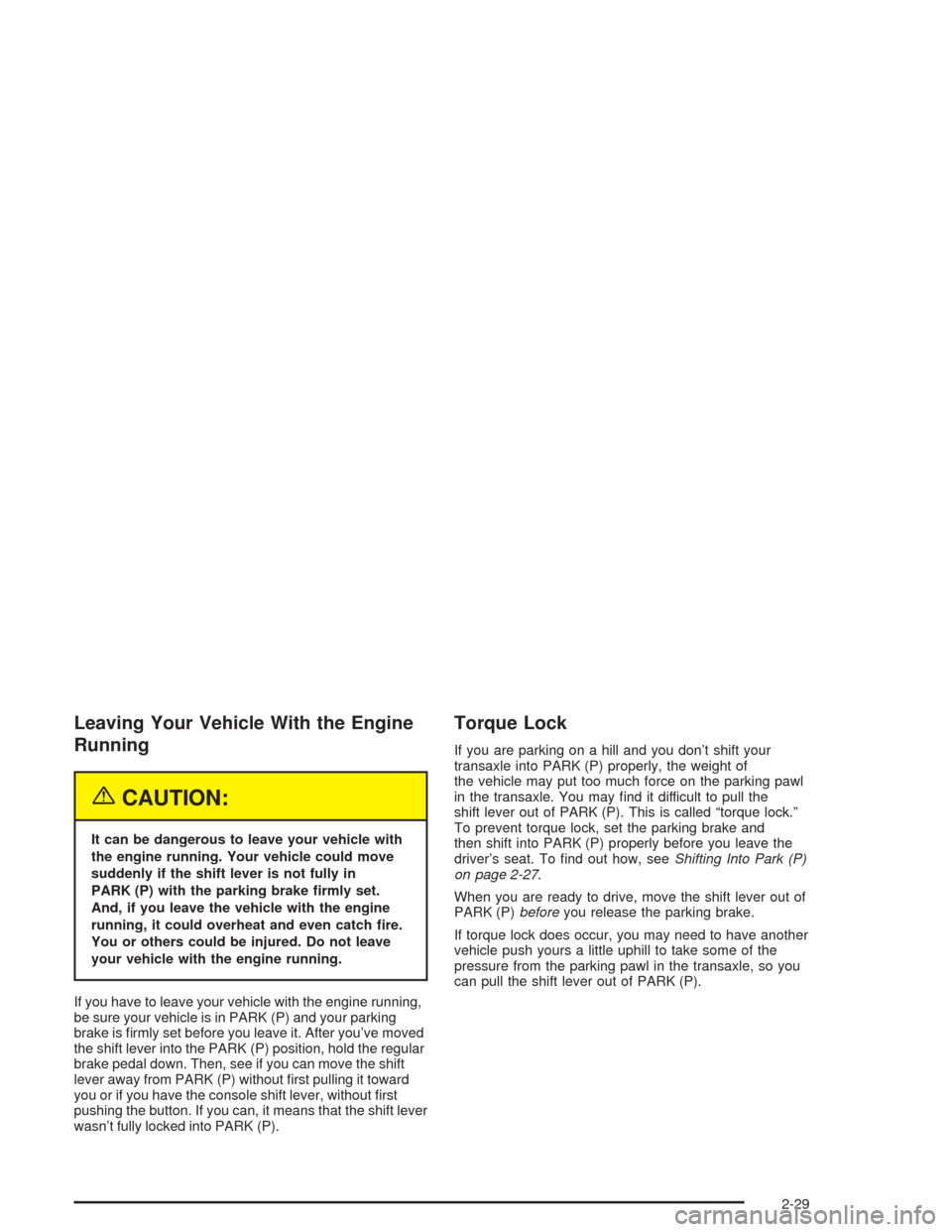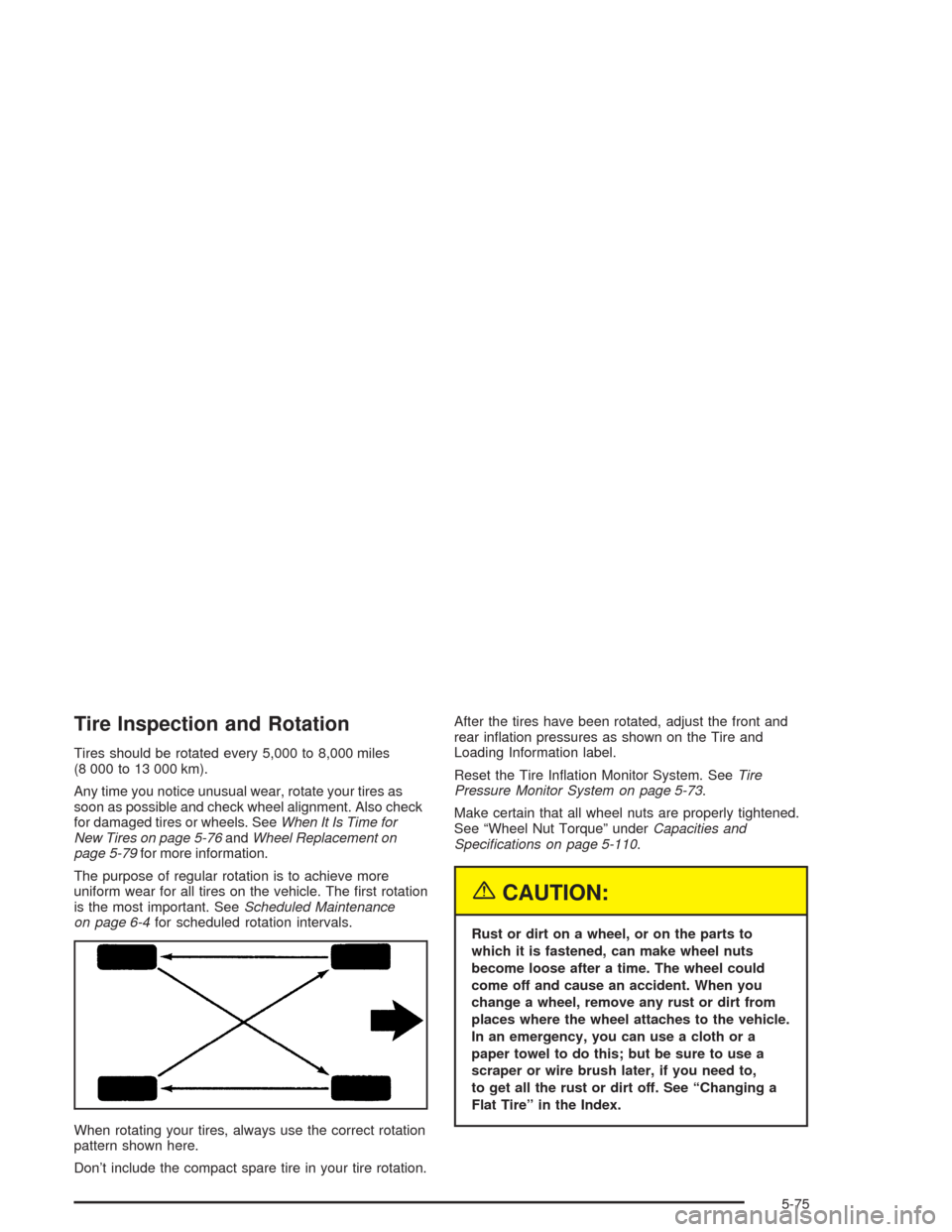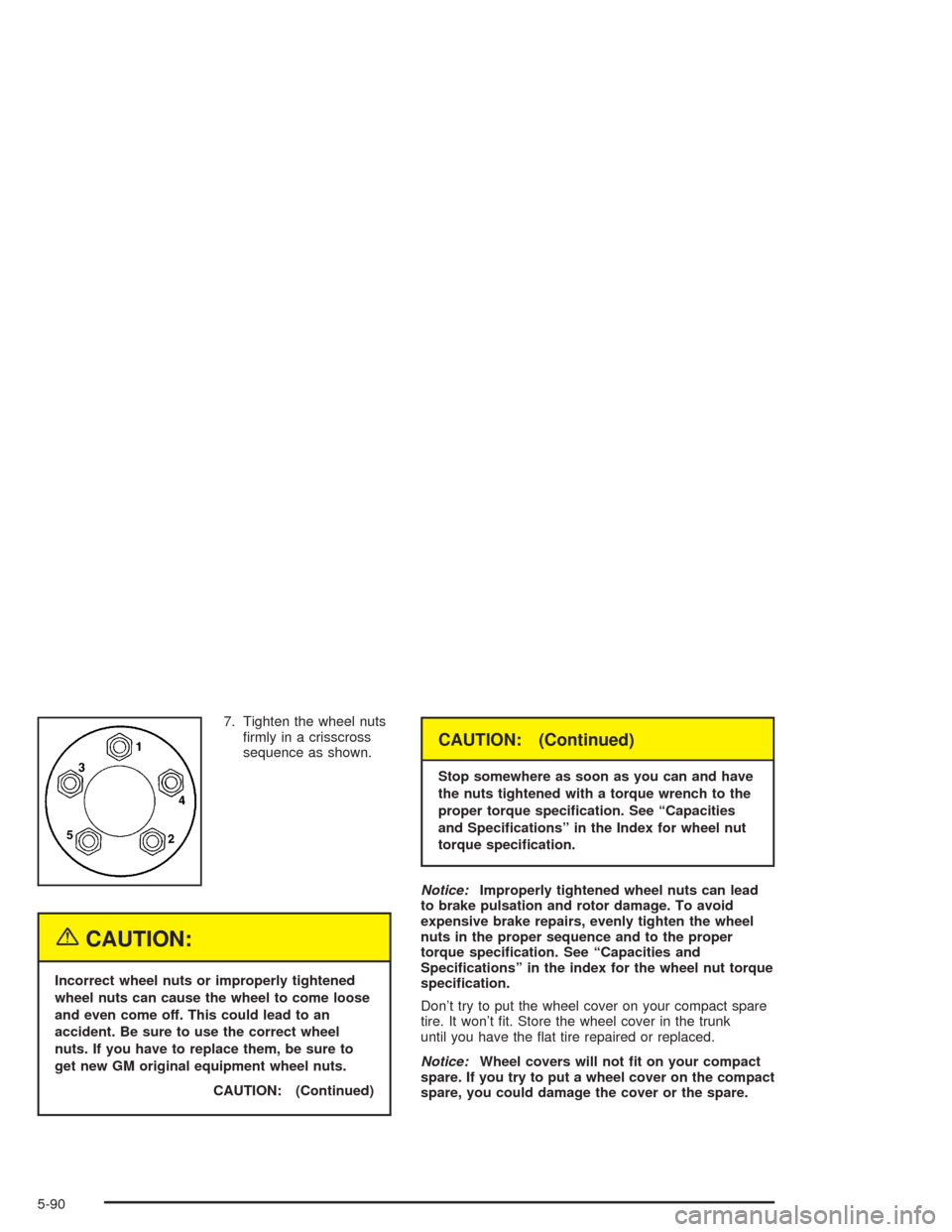2004 CHEVROLET IMPALA torque
[x] Cancel search: torquePage 97 of 420

Leaving Your Vehicle With the Engine
Running
{CAUTION:
It can be dangerous to leave your vehicle with
the engine running. Your vehicle could move
suddenly if the shift lever is not fully in
PARK (P) with the parking brake �rmly set.
And, if you leave the vehicle with the engine
running, it could overheat and even catch �re.
You or others could be injured. Do not leave
your vehicle with the engine running.
If you have to leave your vehicle with the engine running,
be sure your vehicle is in PARK (P) and your parking
brake is �rmly set before you leave it. After you’ve moved
the shift lever into the PARK (P) position, hold the regular
brake pedal down. Then, see if you can move the shift
lever away from PARK (P) without �rst pulling it toward
you or if you have the console shift lever, without �rst
pushing the button. If you can, it means that the shift lever
wasn’t fully locked into PARK (P).
Torque Lock
If you are parking on a hill and you don’t shift your
transaxle into PARK (P) properly, the weight of
the vehicle may put too much force on the parking pawl
in the transaxle. You may �nd it difficult to pull the
shift lever out of PARK (P). This is called “torque lock.”
To prevent torque lock, set the parking brake and
then shift into PARK (P) properly before you leave the
driver’s seat. To �nd out how, seeShifting Into Park (P)
on page 2-27.
When you are ready to drive, move the shift lever out of
PARK (P)beforeyou release the parking brake.
If torque lock does occur, you may need to have another
vehicle push yours a little uphill to take some of the
pressure from the parking pawl in the transaxle, so you
can pull the shift lever out of PARK (P).
2-29
Page 311 of 420

Brake Wear
Your vehicle has four-wheel disc brakes.
Disc brake pads have built-in wear indicators that make
a high-pitched warning sound when the brake pads
are worn and new pads are needed. The sound
may come and go or be heard all the time your vehicle
is moving (except when you are pushing on the
brake pedal �rmly).
{CAUTION:
The brake wear warning sound means that
soon your brakes will not work well. That
could lead to an accident. When you hear the
brake wear warning sound, have your vehicle
serviced.
Notice:Continuing to drive with worn-out brake
pads could result in costly brake repair.Some driving conditions or climates may cause a brake
squeal when the brakes are �rst applied or lightly
applied. This does not mean something is wrong with
your brakes.
Properly torqued wheel nuts are necessary to help
prevent brake pulsation. When tires are rotated, inspect
brake pads for wear and evenly tighten wheel nuts in
the proper sequence to GM torque speci�cations.
Brake linings should always be replaced as complete
axle sets.
Brake Pedal Travel
See your dealer if the brake pedal does not return to
normal height, or if there is a rapid increase in
pedal travel. This could be a sign of brake trouble.
Brake Adjustment
Every time you apply the brakes, with or without the
vehicle moving, your brakes adjust for wear.
5-49
Page 337 of 420

Tire Inspection and Rotation
Tires should be rotated every 5,000 to 8,000 miles
(8 000 to 13 000 km).
Any time you notice unusual wear, rotate your tires as
soon as possible and check wheel alignment. Also check
for damaged tires or wheels. SeeWhen It Is Time for
New Tires on page 5-76andWheel Replacement on
page 5-79for more information.
The purpose of regular rotation is to achieve more
uniform wear for all tires on the vehicle. The �rst rotation
is the most important. SeeScheduled Maintenance
on page 6-4for scheduled rotation intervals.
When rotating your tires, always use the correct rotation
pattern shown here.
Don’t include the compact spare tire in your tire rotation.After the tires have been rotated, adjust the front and
rear in�ation pressures as shown on the Tire and
Loading Information label.
Reset the Tire In�ation Monitor System. SeeTire
Pressure Monitor System on page 5-73.
Make certain that all wheel nuts are properly tightened.
See “Wheel Nut Torque” underCapacities and
Speci�cations on page 5-110.
{CAUTION:
Rust or dirt on a wheel, or on the parts to
which it is fastened, can make wheel nuts
become loose after a time. The wheel could
come off and cause an accident. When you
change a wheel, remove any rust or dirt from
places where the wheel attaches to the vehicle.
In an emergency, you can use a cloth or a
paper towel to do this; but be sure to use a
scraper or wire brush later, if you need to,
to get all the rust or dirt off. See “Changing a
Flat Tire” in the Index.
5-75
Page 352 of 420

7. Tighten the wheel nuts
�rmly in a crisscross
sequence as shown.
{CAUTION:
Incorrect wheel nuts or improperly tightened
wheel nuts can cause the wheel to come loose
and even come off. This could lead to an
accident. Be sure to use the correct wheel
nuts. If you have to replace them, be sure to
get new GM original equipment wheel nuts.
CAUTION: (Continued)
CAUTION: (Continued)
Stop somewhere as soon as you can and have
the nuts tightened with a torque wrench to the
proper torque speci�cation. See “Capacities
and Speci�cations” in the Index for wheel nut
torque speci�cation.
Notice:Improperly tightened wheel nuts can lead
to brake pulsation and rotor damage. To avoid
expensive brake repairs, evenly tighten the wheel
nuts in the proper sequence and to the proper
torque speci�cation. See “Capacities and
Speci�cations” in the index for the wheel nut torque
speci�cation.
Don’t try to put the wheel cover on your compact spare
tire. It won’t �t. Store the wheel cover in the trunk
until you have the �at tire repaired or replaced.
Notice:Wheel covers will not �t on your compact
spare. If you try to put a wheel cover on the compact
spare, you could damage the cover or the spare.
5-90
Page 418 of 420

Storage Areas (cont.)
Front Storage Area......................................2-42
Glove Box..................................................2-42
Rear Storage Area.......................................2-42
Storing the Flat Tire and Tools..........................5-91
Storing the Spare Tire and Tools.......................5-92
Stuck in Sand, Mud, Ice or Snow......................4-29
Sun Visors.....................................................2-14
Sunroof.........................................................2-43
T
Tachometer....................................................3-31
Taillamps
Turn Signal, Stoplamps and Sidemarker
Lamps....................................................5-61
TCS Warning Light..........................................3-35
Theft-Deterrent, Radio.....................................3-92
Theft-Deterrent Systems...................................2-15
Content Theft-Deterrent................................2-15
Passlock
®...................................................2-16
Tilt Wheel........................................................ 3-7
Tire
Low Message.............................................3-48
Tire In�ation Check........................................... 6-9
TIRE MON (Tire In�ation Monitor Reset)............2-45
Tire Sidewall Labeling......................................5-64
Tire Size.......................................................5-68Tire Terminology and De�nitions........................5-69
Tires.............................................................5-64
Buying New Tires........................................5-76
Chains.......................................................5-80
Changing a Flat Tire....................................5-82
Compact Spare Tire.....................................5-93
If a Tire Goes Flat.......................................5-81
In�ation - Tire Pressure................................5-72
Inspection and Rotation................................5-75
Pressure Monitor System..............................5-73
Uniform Tire Quality Grading.........................5-77
Wheel Alignment and Tire Balance.................5-79
Wheel Replacement.....................................5-79
When It Is Time for New Tires......................5-76
To Use the Engine Coolant Heater....................2-21
Top Strap......................................................1-42
Top Strap Anchor Location...............................1-43
Torque Lock...................................................2-29
Total Weight on Your Vehicle’s Tires..................4-40
Towing
Recreational Vehicle.....................................4-30
Towing a Trailer..........................................4-37
Your Vehicle...............................................4-30
Traction
Active Message...........................................3-44
Control System (TCS).................................... 4-8
Control System Warning Light.......................3-35
Service Traction System Warning Message.....3-43
14